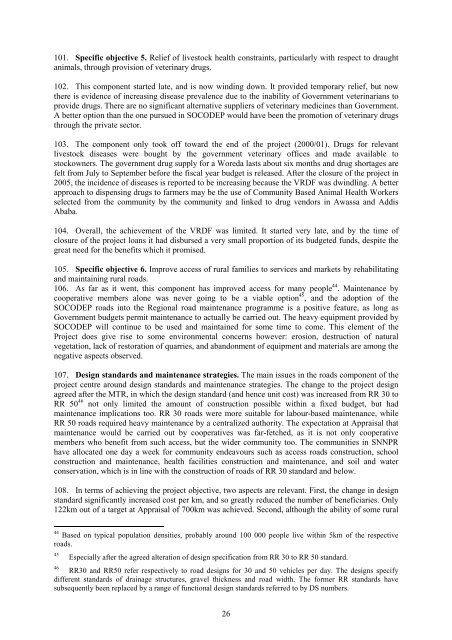Ethiopia SOCODEP CE - main report - IFAD
Ethiopia SOCODEP CE - main report - IFAD
Ethiopia SOCODEP CE - main report - IFAD
Create successful ePaper yourself
Turn your PDF publications into a flip-book with our unique Google optimized e-Paper software.
101. Specific objective 5. Relief of livestock health constraints, particularly with respect to draught<br />
animals, through provision of veterinary drugs.<br />
102. This component started late, and is now winding down. It provided temporary relief, but now<br />
there is evidence of increasing disease prevalence due to the inability of Government veterinarians to<br />
provide drugs. There are no significant alternative suppliers of veterinary medicines than Government.<br />
A better option than the one pursued in <strong>SOCODEP</strong> would have been the promotion of veterinary drugs<br />
through the private sector.<br />
103. The component only took off toward the end of the project (2000/01). Drugs for relevant<br />
livestock diseases were bought by the government veterinary offices and made available to<br />
stockowners. The government drug supply for a Woreda lasts about six months and drug shortages are<br />
felt from July to September before the fiscal year budget is released. After the closure of the project in<br />
2005, the incidence of diseases is <strong>report</strong>ed to be increasing because the VRDF was dwindling. A better<br />
approach to dispensing drugs to farmers may be the use of Community Based Animal Health Workers<br />
selected from the community by the community and linked to drug vendors in Awassa and Addis<br />
Ababa.<br />
104. Overall, the achievement of the VRDF was limited. It started very late, and by the time of<br />
closure of the project loans it had disbursed a very small proportion of its budgeted funds, despite the<br />
great need for the benefits which it promised.<br />
105. Specific objective 6. Improve access of rural families to services and markets by rehabilitating<br />
and <strong>main</strong>taining rural roads.<br />
106. As far as it went, this component has improved access for many people 44 . Maintenance by<br />
cooperative members alone was never going to be a viable option 45 , and the adoption of the<br />
<strong>SOCODEP</strong> roads into the Regional road <strong>main</strong>tenance programme is a positive feature, as long as<br />
Government budgets permit <strong>main</strong>tenance to actually be carried out. The heavy equipment provided by<br />
<strong>SOCODEP</strong> will continue to be used and <strong>main</strong>tained for some time to come. This element of the<br />
Project does give rise to some environmental concerns however: erosion, destruction of natural<br />
vegetation, lack of restoration of quarries, and abandonment of equipment and materials are among the<br />
negative aspects observed.<br />
107. Design standards and <strong>main</strong>tenance strategies. The <strong>main</strong> issues in the roads component of the<br />
project centre around design standards and <strong>main</strong>tenance strategies. The change to the project design<br />
agreed after the MTR, in which the design standard (and hence unit cost) was increased from RR 30 to<br />
RR 50 46 not only limited the amount of construction possible within a fixed budget, but had<br />
<strong>main</strong>tenance implications too. RR 30 roads were more suitable for labour-based <strong>main</strong>tenance, while<br />
RR 50 roads required heavy <strong>main</strong>tenance by a centralized authority. The expectation at Appraisal that<br />
<strong>main</strong>tenance would be carried out by cooperatives was far-fetched, as it is not only cooperative<br />
members who benefit from such access, but the wider community too. The communities in SNNPR<br />
have allocated one day a week for community endeavours such as access roads construction, school<br />
construction and <strong>main</strong>tenance, health facilities construction and <strong>main</strong>tenance, and soil and water<br />
conservation, which is in line with the construction of roads of RR 30 standard and below.<br />
108. In terms of achieving the project objective, two aspects are relevant. First, the change in design<br />
standard significantly increased cost per km, and so greatly reduced the number of beneficiaries. Only<br />
122km out of a target at Appraisal of 700km was achieved. Second, although the ability of some rural<br />
44 Based on typical population densities, probably around 100 000 people live within 5km of the respective<br />
roads.<br />
45 Especially after the agreed alteration of design specification from RR 30 to RR 50 standard.<br />
46 RR30 and RR50 refer respectively to road designs for 30 and 50 vehicles per day. The designs specify<br />
different standards of drainage structures, gravel thickness and road width. The former RR standards have<br />
subsequently been replaced by a range of functional design standards referred to by DS numbers.<br />
26

















